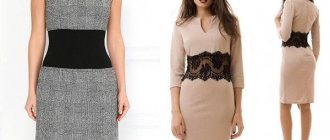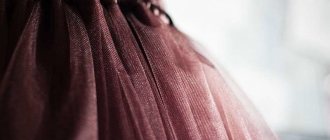Is it possible to iron a wedding dress?
When buying a wedding dress in a salon, it is advisable to immediately ask where you can steam it and other wedding accessories. If it is not possible to order steaming services, and the fabric cannot be straightened with steam at home, in most cases it will have to be ironed. When ironing a wedding dress, you should remember that you cannot use steam while the iron is on the fabric. When processing fabric in this way, you should adhere to the following rules:
- You should only iron your wedding dress at 1 or 2 iron power. The choice of power should start with less. If there is a result, it cannot be increased.
- For each type of fabric you need to select the appropriate mode. The fabric should be processed with an assistant who will straighten and lay out the material.
- You cannot touch the fabric of the outfit with the iron. The material is processed exclusively through a gasket - gauze folded in four or white cotton fabric.
- If the bodice of the dress is trimmed with decorative elements, it is ironed inside out, while placing a terry towel on the board so that it holds the rhinestones and sequins. If the bodice does not have decorative elements, the front side should be ironed.
If you need to iron the veil, start only from the very edge. The iron temperature should be set to the lowest possible setting. Often the veil is made of materials that are very easily damaged when exposed to high temperatures, so the veil should be ironed through double ironing at the lowest temperature.
How to properly iron a wedding dress?
To iron a wedding dress at home using an iron, you must strictly follow the simple instructions:
- First of all, prepare an iron (make sure that the surface of the device is clean, otherwise stains will remain on the fabric), gauze, pre-folded in several layers, clothes hangers and an ironing board.
- If you are comfortable, you can iron the dress on the floor, but then you will need an assistant.
- Before ironing, carefully read the label on the clothing, which should indicate the composition of the fabric. For the manufacture of almost all wedding dresses, polyester is used, which is not one of the highly wrinkled materials.
- It happens that an outfit gets wrinkled in the box during transportation. In this case, try on the dress again to check which parts need ironing. Often ironing is not required for the bodice, but the skirt must be ironed.
Wedding dress bodice
Before ironing the bodice of the wedding dress, carefully inspect the fabric for small wrinkles; they should be sprayed with water. Thanks to this, these folds will be able to “spread” slightly and straighten out before you start ironing. Iron all wrinkles, even the smallest ones. Use another simple tip: hang your wedding dress for a while in the bathroom where you recently took a hot shower. Humidity has a beneficial effect on the material and helps smooth out all wrinkles easily.
It is recommended to start ironing a wedding dress from the bodice. Provided that no additional complex elements were used for its decoration (for example, rhinestones, beads, lace, convex embroidery), you can iron the bodice from the front side. Otherwise, turn the dress inside out and iron it inside out. Cover the board in advance with a soft, light-colored terry towel to protect the decor from damage.
Sleeves and hem
As soon as the bodice of the dress takes on the proper appearance, you can begin ironing the sleeves of the dress, if any. To do this, use special stands that are available on ironing boards. When ironing, apply only light pressure to the fabric. At the end of the procedure, take sheets of paper, roll them into a cylinder shape and insert them into the ironed sleeves. Thanks to this little trick, the sleeves will no longer wrinkle and will retain their shape.
You can start ironing the hem. Place the skirt on the ironing board so that the material lies as loosely as possible and does not stretch. First you need to process the petticoat, and use gauze or a special fabric designed for ironing as a filter. If you have a steamer, it is best to use it instead of an iron. The dress is hung on hangers and all the folds are worked out.
Decorative details
If you have chosen a wedding dress decorated with additional elements (for example, ribbons or bows), then you will need to iron them next. When ironing bows, use the same stand as when ironing sleeves. The most important thing is to choose the optimal temperature for ironing each decorative element, taking into account the material from which it is made. Often the fabric used for a belt or bows has significant differences from the main dress material.
Plume
The train of the dress deserves special attention; you need to iron it from the front side, after which you should also work on the reverse side. First of all, the side seams are ironed, then the train is attached to an additional hanger (it needs to be positioned a little further from the main one). At the end, once all the details have been ironed, the clothes are left for some time at room temperature to cool. It is advisable to prepare your outfit at least one night before the holiday itself. This will give you time to correct minor flaws.
Steaming methods
Some wedding salons or dry cleaners provide a wedding dress steaming service at your home. If this service is affordable and you can order it, be sure to seek help from specialists. They process fabric at the highest level using equipment that is inaccessible to most housewives.
If it is not possible to order such a service, you have to resort to home methods for processing the outfit. These methods can be:
- a pan of boiling water;
- steam in the bathroom;
- home steamer;
- iron with steam release function.
The rules for processing fabrics using these methods will be described below. It should be understood that each specific dress has its own method. Not all fabrics should be treated the same. When choosing a method, you should give preference to the safest and most accessible.
Steamer
Using a steamer is the best option for treating folds in fabric. When processing clothes, you should adhere to the following rules:
- The dress should hang on hangers or on a hanger so as not to touch other clothes.
- By steaming, large areas of fabric should be treated first: a skirt, large bows, hem, and should be finished with the bodice and sleeves.
- It is necessary to steam each layer of the skirt. If the bottom or intermediate layer is not ironed, the skirt will refuse to lie nicely and evenly, and the fluffy outfit will take on an uneven shape. In addition, during wedding photo shoots, not only the upper, but also the lower layers of the skirt are often visible, so it should look flawless.
- After completing the steaming procedure for 3-5 hours, the outfit should hang. At this time, it cannot be put away in the closet or worn. Firstly, hot fabrics will straighten out under the weight of their own weight, and secondly, still warm, damp fabric wrinkles easily.
It is advisable to carry out the steaming procedure a few days before the celebration. By the time of the wedding, the dress will have rested and there will be less chance of wrinkles. If, after the clothes have cooled, any defects are visible, there should be time before the wedding celebration to correct them.
Pot of boiling water
Steaming a wedding dress is possible even without a steamer. A pan of boiling water partially replaces its function. Small areas of material should be treated in this way. This method is suitable if you need to straighten a veil, decorative elements or a small part of the dress. The procedure should be carried out with at least one, and preferably two, assistants. It is important to keep the following cautions in mind:
- The steam temperature is not controlled.
- Clothes should not be brought close to the pan.
- Do not allow fabrics and pans to come into contact.
- Fabric processing time is limited.
- When working with the veil, it is necessary to keep it as far away from the pan as possible and expose it only to short-term exposure to steam. It should be at least 50 cm from the container.
- Do not allow drops to get on the fabric.
The more beads, rhinestones and decorative elements the veil has, the farther it needs to be kept from the pan so that the decor does not come off.
Using an iron
Steaming clothes using an iron is not a good idea. If there is a need to use an iron, then the outfit is ironed rather than steamed. When operating steam through an iron, the following difficulties arise:
- Along with the steam, the iron often releases drops of water. By running the iron over the fabric, the drops are smeared and leave streaks. These stains are very noticeable even after the fabric has completely dried.
- It is almost impossible to control the steam supply. Steam comes out when touching the fabric, its quantity and intensity are invisible.
- The steam makes the fabric hot, and when processed on the board while steaming the next section, the layer that has not yet cooled down wrinkles again. To avoid this, after exposing one piece of fabric to steam from the iron, wait for it to completely cool and dry (and this takes a lot of time), and then process the second one. If you wait for such a long time, the iron often overheats.
To avoid the difficulties described above, if it is not possible to process the dress otherwise, it should be ironed with an iron without a steam function. Use dry gauze for ironing.
When preparing for a wedding celebration, you should think about all the nuances and details, including ironing the outfit. Ideal for such a case would be to order a steaming procedure at home. This procedure is not always accessible; you have to resort to processing the dress at home. To do this, different methods should be used. When processing a wedding dress, you should remember the precautions and rules for processing fabric, so it is advisable to invite an assistant to carry out the procedures.
Try to avoid ironing
No matter how carefully you store the dress and no matter how carefully you dry it after washing, small wrinkles and slight wrinkles will most likely still appear on it. If there are no strong creases, then ironing can be completely avoided by using the wonderful properties of steam. At the same time, it is not necessary to borrow an expensive steam generator from friends: at home, steam is easily created using improvised means.
- To begin with, you can hang the dress in the bathroom after you take a hot shower. The air after the bath procedures will be filled with soft steam, and after hanging there for about an hour, the dress will straighten out and small bruises will be smoothed out.
- A more powerful option is to leave the dress in the bathroom with a hot bath running. The wrinkles will straighten out even faster, and this is one of the best options for eliminating dents at home.
- If you find local creases that are not very strong, then you can straighten them under a hotter and more concentrated stream of steam that comes from boiling water in a pan. Just keep the fabric away from fire and a hot metal pan, especially if it is synthetic!
- For stronger local creases, you can use a jet of steam from the spout of the kettle, but due to the risk of damaging the product, the last 2 methods are still undesirable.
We recommend: Is it possible to iron wool items? Is it true that this causes them to deteriorate?
This method can be used with both natural fabrics and synthetic ones - tulle or organza. The only thing is that synthetics do not react well to high temperatures, and too hot steam can cause the fabric to deform or even melt, causing a real hole! Therefore, it is not recommended to straighten creases in tulle over steam from the spout of a teapot or under a directed stream of steam from an iron.
Advice
You can iron out small wrinkles at home without steam: just spray a little clean water on the wrinkled area from a spray bottle and dry it with a hairdryer!
For those who decide to wash the dress, the scheme remains the same, but two important steps will be added to it: using conditioner to prevent severe creases and carefully drying on a hanger in the most straightened state.
By the way, sometimes before taking any action, much less ironing the dress, it would be better to just let it hang at home for several days. This simple step will greatly reduce the effort you have to put into getting your dress in order.
Where can you steam a dress for a wedding?
You can remove wrinkles by:
- wedding salon;
- dry cleaning;
- studio;
- cleaning company;
- at home.
Many wedding and evening fashion salons provide a free ironing service for purchased outfits. Sometimes you have to pay an additional 300-1000 rubles for this. It depends on the interior, the characteristics of the material and the time it will take to work.
At the dry cleaner you will have to pay 200-500 rubles. A similar service in a studio costs about the same. Ironing of used clothes, which are planned to be returned after the celebration, is required. Those who are not sure whether to get rid of an item should find out whether a wedding dress can be sold.
Specialists from cleaning companies will cope with the task for 1000-2000 rubles.
Almost everywhere, steamers are used to smooth out uneven surfaces. Despite this, it is advisable for brides to first read reviews about the company that she plans to entrust with the care of such a delicate and important outfit.
Ways to steam a wedding dress at home
You can smooth out wrinkles on a dress at home using:
- steamer;
- steam from water in the bathroom;
- iron.
There are vertical and compact (manual) steamers on the market. Advantages of the first models:
- cope with eliminating wrinkles even on dense materials;
- equipped with a long power cord;
- work from the network (no need to spend money on batteries);
- equipped with a special stand with hangers.
A handheld steamer is convenient to take with you if ironing takes place outside the home. It weighs no more than 0.5 kg.
It must be taken into account that most compact devices cannot smooth out thick fabrics and do not have a long enough cord.
How to use a steamer correctly
Step-by-step instruction:
- Hang the outfit on hangers.
- Fill the device with clean water.
- Turn on the steamer.
- Stretch the uneven area.
- Run the device along the folds (from top to bottom).
- After steaming, the dress must be left to cool.
Advantages of steamers:
- speed – steaming will not take more than 10-20 minutes;
- fight against pathogenic microorganisms - they ensure the elimination of microbes, viruses, dust mites from the surface of clothing;
- ideal smoothness - no shiny areas on the treated surface;
- obedience of the fabric - high-quality elimination of the slightest creases.
Features of using the iron
Ironing is a budget-friendly but labor-intensive method.
It is almost impossible to smooth out all existing wrinkles on your own without ruining the outfit. There may be yellow spots left on it.
It is advisable to enlist the help of an assistant (mother or friend).
Step-by-step instruction:
- Place the dress on the ironing board, ironing begins with the bodice.
- Lightly moisten all creases in the fabric with water.
- You need to set the iron to the “delicate” setting and make sure that the soleplate is clean.
- Place gauze or bandage moistened with water and folded in several layers on top of the dress fabric. Products decorated with rhinestones and embroidery are ironed from the reverse side.
- If there are sleeves, after ironing, it is advisable to insert cylinders of rolled paper, white, without printing, into them.
- Place the skirt on the ironing surface and iron it, moving the fabric in a circle. First, smooth out the underskirt, and only then the upper.
- If there is a train, it must be ironed on both sides.
After ironing by any method, the product should be left hanging on hangers to avoid re-formation of wrinkles.
Here is a video in which dry cleaning staff give useful tips on washing, storing and steaming a wedding dress:
No matter how many effective ways there are to steam a dress at home, it is still better to turn to professionals.
Using steam in the bathroom
The bath is another place where you can put your outfit in order. This is one of the most budget-friendly and easiest ways to deal with creases in fabric. The outfit is hung on hangers over a bathtub of hot water and left overnight. The hem of the dress should be at least 20 cm from the water.
Despite its apparent simplicity and convenience, this method has disadvantages:
- under the weight of the fabric that has absorbed moisture, the outfit may fall into the water;
- if there are rhinestones on the dress, they may come off;
- not suitable for dresses made of heavy fabrics and with fluffy multi-layered skirts.
Ways to steam a wedding dress at home
You can have your wedding dress steamed by professionals, but more often this does not require much effort, because it is easy to put it in order yourself. There are several ways to steam any fabric:
- Using a saucepan of boiling water.
- Hold over steam.
- Iron.
It is better if you agree with the wedding salon where you made your purchases so that the outfit is steamed immediately before the celebration. All wedding salons have special steamers for clothes, so some even provide this service for free or for a nominal fee. But the dress still needs to be delivered home, and it will still wrinkle on the road. Sometimes one hanger is enough to make the outfit hang, but more often the wedding dress needs to be steamed again. Don't worry: follow our instructions and you will succeed.
Using a pot of boiling water
Some resourceful girls resort to this method: they boil water in a saucepan, and then, with the help of a second person, steam the problem areas of the wedding dress. A veil is also steamed in the same way, just be very careful, because the veil consists of a material in which the steam will quickly make a hole or the fabric will shrink to such an extent that it cannot be repaired.
Hold it over steam in the bath
Some brides pour very hot water into the bath, which produces a lot of steam. First, hang the wedding dress on a hanger above the steam (so that the hem is 20-23 cm above the water). Then the fabric gradually begins to smooth out and straighten from the moist air. But there are also several risks associated with this steaming method:
- firstly, the outfit sometimes falls into the water;
- secondly, if there is decor - sparkles, rhinestones, beads that are glued to the fabric - the decorations can come off under prolonged exposure to moisture;
- thirdly, there are fabrics that cannot be steamed in this way.
Using an iron and gauze
For some reason, girls are afraid to iron their wedding dresses, but there is nothing wrong with that. The main thing is that the dress or veil should be ironed through gauze and not directly. If you do not use thin fabric when ironing, the bride’s outfit can easily be ruined. Stores sell special fabrics for such cases, through which any materials can be ironed, so if there is no gauze in the house, there is always a way out. To iron a wedding dress you will need:
- iron;
- ironing board;
- gauze or thin white cloth;
- water sprayer.
It is advisable to have someone present when ironing a wedding dress to hold, straighten and turn it. It is very difficult to iron a full skirt alone. We set the temperature to one, maximum to two. It is better not to use steam, but if the fabric does not smooth out at all, then you can turn on the steam on a delicate mode. Dry gauze should be folded in 2-3 layers, placed on the dress and lightly ironed. If the result is visible, then feel free to continue the process; if not, then the temperature of the iron should be increased slightly.
If the wedding dress contains different fabrics, then the iron should be adjusted for each specific material. For example, satin should be ironed on a double iron and the steam function should be used. It is advisable to iron organza on one unit, and using steam is not recommended at all. Don't forget to use gauze in all cases! When ironing a veil, try ironing just the edge first to make sure the material doesn't get damaged before moving on to full ironing. So, the rules:
- First, start ironing the bodice. If there are decorative elements, then first place a terry towel on the ironing board, and iron the bodice from the inside. If there are no chains, locks, rhinestones or lace on it, then feel free to iron the outside of the bodice.
- There is a special stand on the ironing board for ironing sleeves. In order for the fabric on the sleeves to smooth out, just a little pressure from the iron on the desired area is enough. To prevent the sleeves from becoming wrinkled after ironing, place curled sheets of paper in them.
- Bows and ribbons are usually made from different types of fabric, so adjust for each accessory separately. When ironing, the greatest attention should be paid to the skirt: start with the bottom layer, using gauze, setting the delicate mode, and finish with the top layer of the skirt.
Video tips for performing the procedure at home
It’s easy to get rid of existing folds, straighten ruffles and frills, and tidy up fabric at home. Experts will tell you in the video how to steam a wedding dress just brought from the salon at home:
Pros and cons of steaming wedding dresses
The bride is the central figure at the wedding, and her dress should look impeccable. To do this, you need to carefully iron the wedding dress, regardless of whether it is new or rented from a bridal rental shop. Salons provide this service, sometimes it is included in the price of purchased holiday clothes, it can be ordered for an additional fee. You can do this in a private laundry, which is done at the customer’s home or at the contractor’s premises with subsequent transportation.
When ironing a satin wedding dress, water should not be used as it easily stains the fabric.
If you have a limited budget for a wedding or time pressure, ironing a wedding dress is necessary at home. This option has its pros and cons. The work performed by a professional is always impeccable, but in everyday life it is often impossible to provide the required level due to the outfit itself. It can have several skirts, a long train, and is made of fabric, which must be ironed extremely carefully in compliance with a certain temperature regime. In addition, the rented dress must be cleaned of the odors of the previous client, and this is only possible with a steam cleaner, which you also need to know how to work with. There is a serious danger of ruining your outfit a few hours before the ceremony. The only pleasant thing is saving money.
Ironing at home
Independent manipulation of a holiday outfit can lead to its damage.
When carrying out this important procedure, experiments are undesirable. A method such as using a pan of boiling water can ruin the dress irrevocably. The lace will turn yellow, the veil or petticoat will shrink. Steam, especially if the container with boiling water is not properly rinsed, can leave stains. If you hang your wedding dress in a steamed bathroom, the fabric may absorb the smells of washing powder.
Steaming over a bathtub, when a dress is hung on a hanger above hot water at a distance of up to 25 cm, also does not always give positive results. First of all, the outfit may fall into the water. If exposed to moisture, glitter and other attached decorations may fall off. On the other hand, there are fabrics that cannot be ironed using this method.
It is better to iron a wedding dress together because of the large volume and inconvenience of working with it alone. The sequence is:
- Be sure to use an iron made from 2-3 layers of gauze, or preferably cotton fabric.
- The iron is set to the minimum temperature.
- If a wedding dress is made from several types of fabric, then a suitable thermal regime is selected for each.
- First the bodice is processed. If there is an abundance of decorative elements on it, then from the inside, smooth - on the top.
- The sleeves are ironed on a special stand, which is often included with the ironing board.
- Skirts are processed both upper and lower.
- The outfit should “rest”, that is, dry out. Therefore, the process is carried out at least 12 hours before the ceremony.
Sometimes ironing is not required; the wedding dress will hang on the hanger itself.
A reliable and proven method of home steaming
It is ideal to iron a wedding dress using a steam cleaner. The outfit is put on a hanger, hung and treated with a jet of steam from a distance of 15 cm. This method allows you to ideally smooth out bows, ruffles, folds, lace, and other decorative elements. This is the only way to update your cleaning routine and get rid of foreign odors. The danger of irreversibly damaging the formal attire is reduced to a minimum.
How to iron a dress yourself?
Ironing a wedding dress correctly is not difficult if you take into account a few nuances, although, let's be honest with you: it will take a lot of time, and it will be very difficult to prevent the formation of wrinkles on the already ironed part of the dress. But if you have a board, an iron, cotton fabric and a lot of patience, then you can still cope with the problem.
- First of all, you need to take care of the cleanliness of the room in which you will iron, the surface of the iron, the water and the steaming compartment itself if you are going to use steam.
- Start ironing from the top of the product, and always do it correctly from the inside out! By the way, it is better to check the reaction of the fabric to the selected mode first on an inconspicuous area: even with a layer of cotton and ironing from the inside out, there is a risk of deformation of the fabric, especially if it is tulle or other delicate synthetics.
- Before ironing the skirt, you should also iron all the ribbons and bows.
Advice
The sleeves are ironed from the inside out on a special stand, and then a folded sheet of paper is inserted into them to prevent creasing.
- Now the dress is hung on a hanger, secured and the long process of ironing the skirt begins. Or, more accurately, skirts. At the very end, they iron the train, and then hang the dress to wait in the wings.
- It is also correct to iron a veil only through a layer of gauze or cotton and on the minimum setting, because it is easiest to ruin it!
We recommend: How to iron a shirt quickly and efficiently - instructions for young housewives
Don't forget that a dress usually consists of several types of fabric, and you will have to adjust the mode for each of them. Although it is always recommended to start with the most gentle one!
Features of ironing and steaming dresses with various materials
Everyone knows that each fabric has its own processing characteristics. For everything to work out at its best, you need to accurately identify the material and learn about its properties.
Atlas
The most important feature is that clothes of this material are always ironed only from the inside.
Under no circumstances should you use the steaming function, satin does not absorb moisture and marks will remain!
Ironing process:
- Place a thick fabric between the ironing board and the outfit.
- Select the silk program.
- Slowly move the iron over the material.
- Be sure to let the area cool, otherwise the fabric will break.
- You can move on to the next place.
Chiffon
It is a delicate type of fabric and therefore requires special care. Steaming occurs by weight. The outfit is placed on a hanger and processed with the device from top to bottom, carefully passing over problem areas. Be sure to keep the steamer at a safe distance.
Lace
Steaming occurs at the lowest possible temperature. Otherwise, the lace outfit will instantly turn yellow.
When ironing or steaming, the fabric must be covered with thick material to prevent melting. Cuffs and collars are treated with liquid starch to give them a dazzling whiteness.
Tulle decorated with sequins and beads
To avoid damage to the decor, it is necessary to carry out the steaming procedure at a safe distance. When steaming a tulle dress, it is best to trust the professionals; they will definitely not ruin the outfit.
Final Recommendations
As you can see, steaming a wedding dress yourself is a very difficult and sometimes dangerous task, so I would recommend leaving it to professionals.
And in order to save money, you can ask to leave the dress in the salon until the eve of the wedding (many salons provide this service free of charge). This will allow you to solve two problems at once: firstly, you won’t have to figure out where and how to store the dress, and secondly, you will receive it in perfect condition the day before the wedding and all you have to do is hang it carefully until tomorrow.
Sources
- https://odezhda.guru/platya/svadebnoe/610-otparit
- https://wedding-fabric.ru/molodozheny/nevesta/svadebnoe-plate/otparit.html
- https://HozSekrety.ru/glazhka/kak-otparit-svadebnoe-plate.html
- https://alice-wedding.me/obraz-nevestyi/plate/kak-otparit-plate.html











